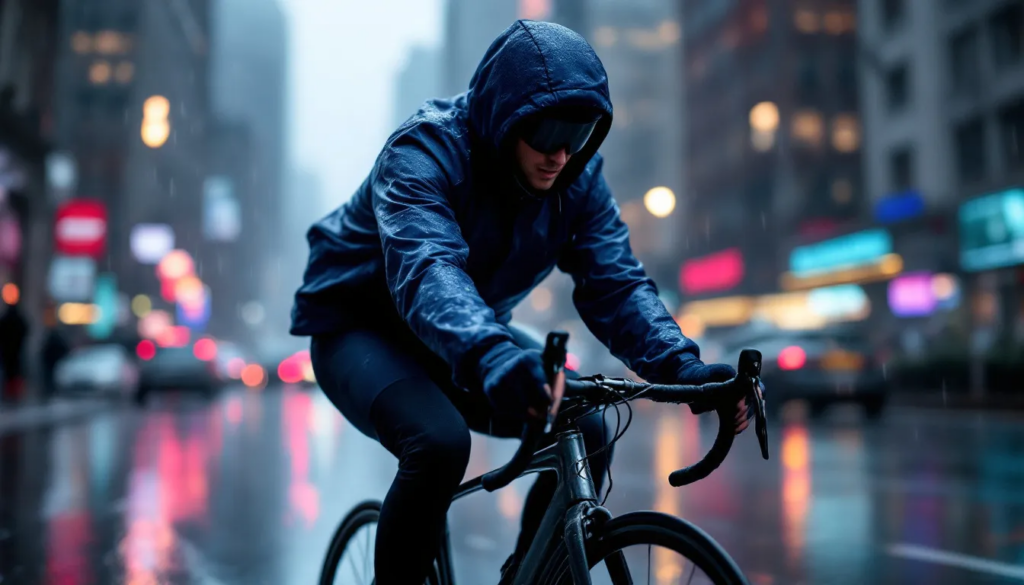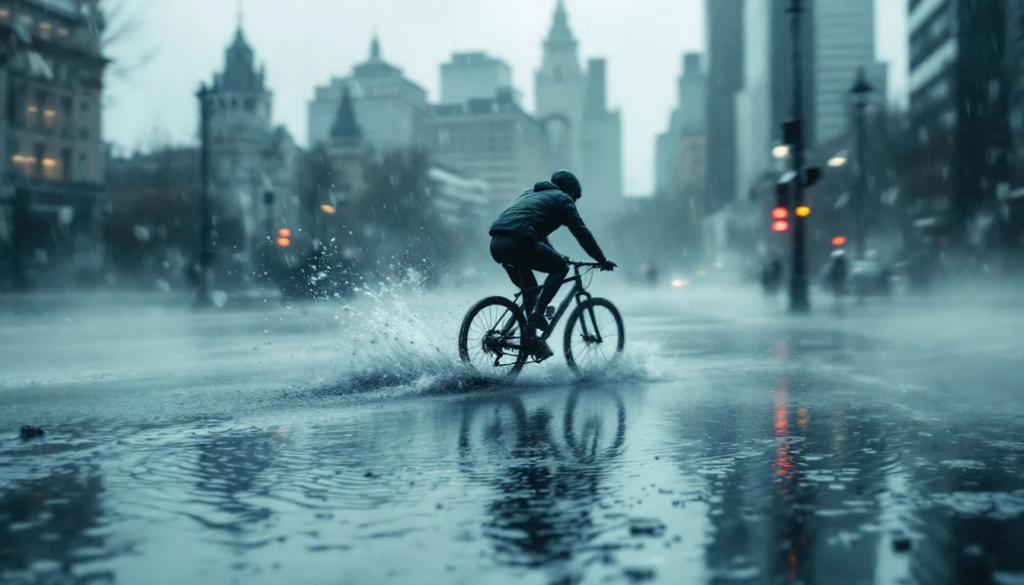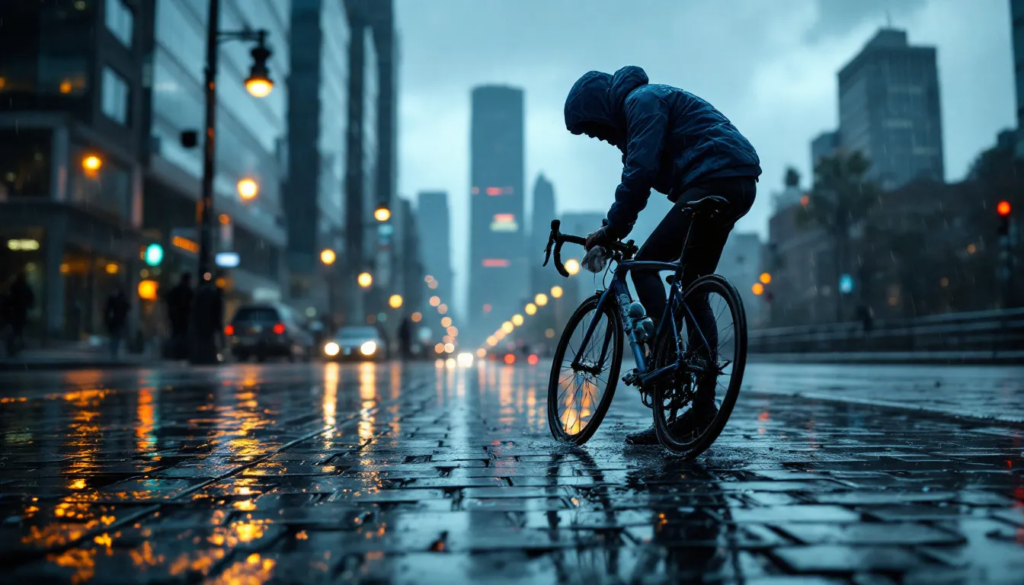Cycling in rain presents unique challenges, but with the right gear and techniques, you can stay safe and comfortable. This article covers essential tips for riding in wet conditions, including choosing the right rain gear, preparing your bike, visibility measures, and post-ride maintenance.
Key Takeaways
Wear proper rain gear like waterproof jackets and shoe covers to stay dry and comfortable while cycling in wet conditions.
Ensure bike safety by maintaining it well—fit mudguards, use wet lube on the chain, and adjust tire pressure for better grip.
Boost visibility when riding in the rain by using lights, wearing reflective gear, and avoiding slippery surfaces to reduce the risk of accidents.
Essential Rain Gear for Wet Weather Riding

Wearing appropriate rain gear ensures safety and comfort in wet conditions. Proper clothing transforms a miserable slog into an enjoyable wet ride.
Waterproof jackets and shoe covers help you stay dry and focused on the road ahead.
Choosing a Waterproof Jacket
A waterproof jacket is essential for any cyclist venturing out in the rain. Its primary function is to keep you dry and warm, ensuring comfort during your ride. Look for features like taped seams to ensure water stays out, and consider materials like Gore-Tex and eVent, which offer superior protection.
Equally important is the breathability of the jacket. Without it, sweat buildup can make you just as wet from the inside. Soft shell jackets offer breathability and lighter weight, making them popular among cyclists.
The Benefits of Cycling Caps
Cycling caps play a significant role in rain gear, keeping water out of your eyes and enhancing comfort during wet rides and cycling in the rain while wearing a cycling rain jacket.
Made from thin fleece or breathable waterproof fabric, cycling caps are designed to provide optimal comfort and performance in the rain.
Investing in Shoe Covers
Shoe covers keep your feet dry and warm during wet rides. Waterproof overshoes shield your feet from rain and prolong the lifespan of your regular shoes.
Reflective overshoes are especially recommended for riding in the rain as they improve visibility.
Preparing Your Bike for Wet Conditions

Proper bike maintenance and preparation are crucial for safe cycling in rainy conditions. Rinsing your bike immediately after a ride prevents dirt from adhering, and a waterproof saddle cover keeps the saddle dry.
Use a soft water jet for rinsing your bike instead of a high-pressure sprayer.
Fitting Mudguards
Fitting mudguards to your bike is a simple yet effective way to keep road spray off you and your bike. They prevent tires from splashing water and dirt onto the rider and bike, keeping you cleaner and more comfortable during wet weather riding.
Using Wet Lube
Applying the right lube on your bike chain is essential, particularly in wet conditions. Wet lube stays in place during rain, protecting against rust and ensuring smooth chain operation.
Adjusting Tire Pressure
Reducing tire pressure improves grip and stability on wet surfaces by increasing the contact patch, enhancing control and confidence.
The optimal amount of tire pressure to release depends on factors like the rider’s weight and the size of the tires.
Visibility and Safety Measures

Visibility is paramount when cycling in rainy conditions. Measures like using bike lights, wearing reflective gear, and avoiding slippery surfaces significantly reduce the risk of accidents.
Using Bike Lights
Bike lights increase visibility to other road users in wet weather. Bright lights ensure you are seen, especially under poor visibility conditions.
Rearview radar lights can also notify you of traffic approaching from behind, which is particularly useful in low visibility situations.
Wearing Reflective Gear
Reflective clothing boosts visibility in low-light and rainy conditions. Bright, reflective garments make you more noticeable to drivers, enhancing safety.
Avoiding Slippery Surfaces
Road markings, manhole covers, and drains become slippery when wet, increasing the risk of losing traction. Avoid these surfaces and steer clear of puddles that can hide hazards like deep holes and sharp debris.
Riding Techniques for Rainy Weather

Adapting your riding techniques ensures safety in wet conditions. Modify body positioning, braking techniques, and overall riding style for slippery roads.
Braking Carefully
Brake earlier and gently to avoid sudden stops, which can cause loss of control on slippery surfaces. Rely more on the rear brake to reduce the risk of skidding.
Navigating Puddles and Standing Water
Puddles can conceal hazards like deep holes and sharp debris that damage your bike. Signal and move to the center of the lane to avoid puddles and hidden dangers.
Maintaining Body Heat
Increasing effort level and pedaling intensity generates body heat, keeping you warm in the rain and counteracting the chill.
Post-Ride Bike Maintenance

Post-ride maintenance is crucial for performance and safety on wet roads. This involves cleaning your bike, drying and lubricating the chain, and inspecting brake pads and wheel rims.
Cleaning Your Bike
Wash your bike after a rain ride to prevent dirt buildup. Use a garden hose, warm soapy water, and a sponge for effective cleaning. Avoid power washers, which can damage components.
Drying and Lubricating the Chain
Dry and re-lubricate the chain after a rainy ride to prevent rust and ensure smooth operation with dry lube.
Using a degreaser is an effective method to clean the chain for a deeper clean.
Inspecting Brake Pads and Wheel Rims
Inspect brake pads and wheel rims for wear and damage after a rainy ride.
Regular maintenance of these components ensures optimal performance and safety.
Keeping Yourself Comfortable
Proper rain attire transforms a dreary ride into an enjoyable experience. Manage wet clothing, protect your items, and prevent chafing.
Managing Wet Clothing
Waterproof trousers or shorts shield against rain and insulate your legs. Merino wool socks offer warmth and moisture resistance.
Regular maintenance and reproofing keep your rainwear effective.
Protecting Items You Carry
Use waterproof bags and plastic bags to keep essentials dry during a ride, preventing damage to your belongings.
Preventing Chafing
Chafing cream, chamois cream, and petroleum jelly prevent chafing caused by wet skin, which is more sensitive than dry skin.
Summary
Cycling in the rain can be a rewarding experience if you’re well-prepared. From choosing the right rain gear to maintaining your bike and adopting safe riding techniques, each step is crucial for staying safe and dry on wet roads. Remember to always prioritize your visibility and comfort, and don’t let the rain deter you from enjoying your ride.
Embrace the rain with confidence and let these tips guide you through your next wet weather adventure. Happy cycling!
Frequently Asked Questions
What type of jacket is best for cycling in the rain?** **?
A high-quality waterproof jacket made from materials like Gore-Tex is your best bet for cycling in the rain. It keeps you dry while still being breathable, so you can ride comfortably no matter the weather.
How can I keep my feet dry during a rainy ride?** **?
To keep your feet dry during a rainy ride, invest in waterproof shoe covers and socks. They’ll make a big difference!
Why is it important to use wet lube on my bike chain?** **?
Using wet lube on your bike chain is crucial because it stays in place during wet conditions, protecting against rust and ensuring smooth operation. Keep your bike running efficiently by regularly applying wet lube, especially if you ride in the rain!
What should I do to maintain visibility while cycling in the rain?** **?
To stay visible while cycling in the rain, make sure to use bright bike lights and wear reflective gear. This will greatly improve your safety on the road.
How can I prevent chafing during wet weather rides?** **?
To prevent chafing during wet weather rides, apply chafing cream, chamois cream, or petroleum jelly, as these help protect your skin from moisture. Look for products with soothing ingredients like cocoa butter or aloe vera for extra comfort.


